Sand dunes are a natural wonder with beauty and majesty all their own. However, when you know more about the dunes, they take on even greater significance. Once you learn about the complex, dynamic dune ecosystem, you will appreciate dunes even more. Before we describe sand dunes, we need to know what sand is. Sand is considered any loose, granular material having grains which are 0.05 to 2.0 millimeters in diameter. The designation "sand" does not refer to how the material was formed or what it is made of. Sand can, and does, come from all three major rock types: igneous, metamorphic, and sedimentary. Sand can be primarily one mineral or material, or it can be a mixture.
Sand dunes are mounds of windblown sand which vary greatly in size, from less than one meter to tens of meters high. The size depends upon the supply of sand. There is even greater variation in the area covered by dunes. Many of the more recognizable dune forms are ridges or complexes of mounds or crescents. The shape of individual dunes is equally variable. Shape relates to the direction and strength of the wind forming it, as well as to the amount of sand available. The impressive sand dunes along the eastern shore of Lake Michigan were created by the prevailing westerly winds blowing the sand deposited along the beaches into the dune formations.
Michigan is home to the largest dune system in the world, associated with a freshwater lake. Our sand dunes are found not only along Lake Michigan, however, as the maps below show.
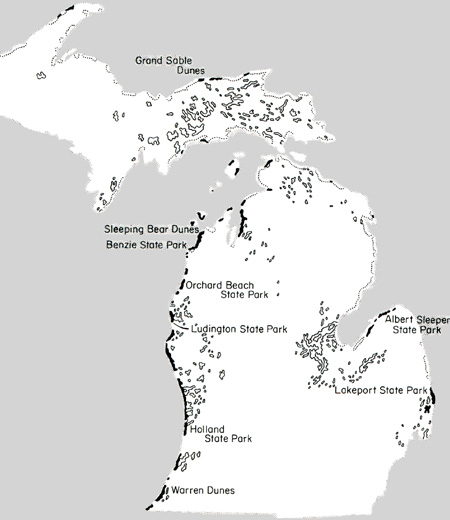
Dunes in Michigan
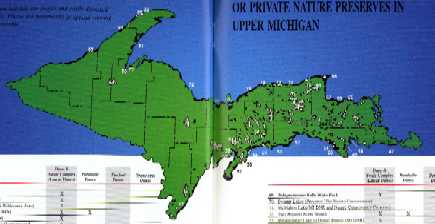
Click here for full size image (552 kb)
Dunes in the UP of Michigan
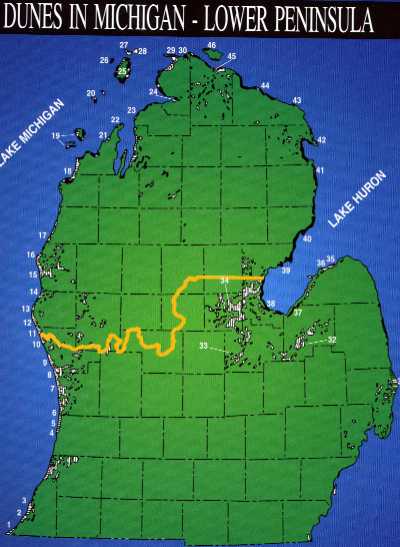
Click here for full size image (487 kb)
Formation of Dunes
Sand dunes form in many areas. However, some requirements must be met. Required elements
are: 1) a source of dry sand, 2) a means to sort and transport the sand, and 3) a land
area on which to deposit the sand. Studies indicate that a supply of dry sand is the most
important factor. A means of transporting and sorting (i.e., wind. water) is not rare or
out of the ordinary. Running water and normal winds can do this. Strong winds or water
action, cannot initiate dune formation, however, without a supply of sand. As mentioned,
the size and shape of a dune depend on the wind and amount of sand available. The amount
of sand being equal, wind conditions have a strong influence on the shape of a dune field.
Constant winds tend to form more regularly shaped dunes or even long ridges. Irregular or
changing wind directions result in irregular-shaped dunes.
The sand making up Michigan’s dunes is almost all one
mineral-quartz. Because quartz grains can form from a number of different rocks, the
original source of the quartz dune sand cannot be singled out. It should be noted that
relatively few bedrock outcrops occur in Michigan. Instead, glacial drift almost
completely covers the state. Therefore, one can safely assume that sand for the dunes
comes initially from glacial deposits. Yet, much of the sand found in drift is mixed with
a variety of other particles, from clay to cobble size. The drift must therefore be
eroded, transported, sorted and redeposited by water---the running water of a river or the
pounding surf of a beach–before it is sorted enough to be a uniform "sand".
Water tends to concentrate sand-sized particles in particular areas.
Continued erosion and transportation of sand replenishes the sand blown
into the dune. As long as more sand is supplied, the dunes will continue to grow. When the
supply diminishes, the dunes are likely to stabilize, or at least stop growing.
The size range of sand grains that make up dunes is remarkably uniform
because grains that are smaller than sand-size (silt or clay) are carried farther away by
the action of wind and water. Grains or stones that are larger than sand-size (pebbles,
cobbles, boulders, and the like) are left behind.
Many of our state parks, including Warren Dunes and Lakeport State Parks, are associated
with sand dunes. And of course, Sleeping Bear National
Lakeshore is a major attraction, with its fantastic beaches and perched dunes.
All along the east coast of Lake Michigan dunes make up a strikingly large part of the
landscape. This image, from near Holland, shows the beautiful dunes and the beaches
that adjoin them.
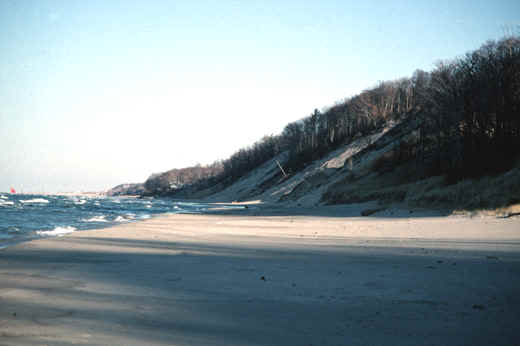
WHERE DO WE FIND SAND DUNES?
In Michigan, sand dunes are found along much of the shoreline of the Great Lakes. The best
known and most studied Michigan sand dune areas are along Lake Michigan. Here, the supply
of dry sorted sand and a prevailing wind direction toward land lead to dune development.
However, close inspection shows that some of the dunes or dune-like structures are not
close to today’s lake shoreline. These inland dunes reflect previous dune-forming
conditions. These dunes are a result of massive ice sheets which covered Michigan, and
much of North America, during the Pleistocene Epoch. Glaciers transported sand and other
materials and deposited them as glacial drift. Large masses of glacial ice gouged out the
basins that now confine the Great Lakes.
However, the glaciers did not simply advance and retreat. Instead, a
complex sequence of advances and retreats occurred. These fluctuations had great impact on
the landforms. At times drift was deposited, forming barriers which ponded meltwater in
large lakes. When the barriers were eroded or otherwise breached, lake levels changed.
When the water level dropped, sand deposits could dry out and then be blown into dunes.
Therefore, one can find dunes along the ancient lake shores where sand accumulated. Yet,
the supply of sand, water and wind varied greatly from area to area. The distribution of
dune landforms usually implies the existence of an old beach. However, the absence of
dunes does not necessarily mean a beach did not exist.
In some places in Michigan, dunes formed on top of the glacial drift.
These dunes are called perched dunes. As the water level changed and migrated, so did the
dunes. If the shoreline retreated, the dunes were more likely to stabilize. And, if
conditions were proper, new dunes formed along the new shoreline. The older dunes, formed
at a higher lake level, remained on the glacial drift. If the shoreline later advanced
with a rising lake level, the older stable beach lines and bluffs were eroded.
When you think of sand dunes, you commonly associate them with the
desert. If Michigan is not a desert, then why do we find dunes here? The answer lies in
the Great Lakes, primarily Lakes Michigan, Superior and Huron. All along the shores of
these beautiful lakes, wave action sorts the sediments in the near-shore area. As the
waves pound the beach, much of the finer-than-sand-sized materials are carried out into
deeper water while the sand-sized grains and larger particles and pebbles are moved nearer
to the beach. During storms, large quantities of sand are moved past the beach. Eventually
these piles dry out. Until the sand dries, water between the grains holds the sand
together. The adhesive quality of the water makes the sand temporarily immobile. The
adhesion does not remain after the sand dries. The dry sand can then be transported and
winnowed by the wind. The wind carries the sand inland, where it is deposited as a dune.
In Michigan the supply of sand is not constant. So, in time, the dunes
become covered with grasses and other forms of vegetation-even trees. When vegetative
cover prevents the wind from moving the sand, the dunes are stabilized (as below).
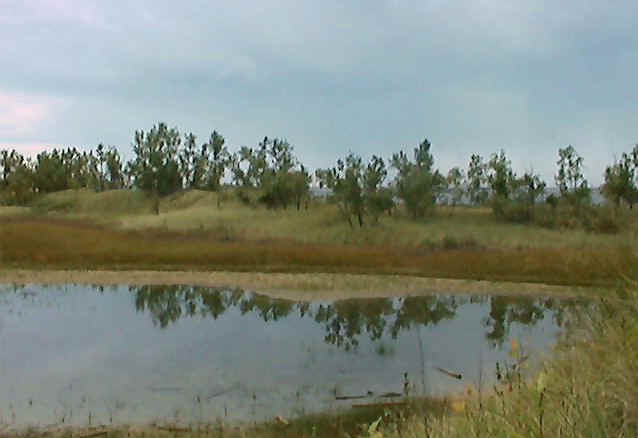
However, if the protective vegetation is removed, or if there are
exceptionally high winds or the groundwater level drops, the sand is exposed to wind
erosion, and movement or migration begins again. The area where migration begins is called
a blowout. Renewed dune movement can bury anything in its path, even the forests which
once may have stabilized the dune.
There are three major types of dunes in Michigan: inland
dunes, coastal dunes, and perched coastal dunes.
Many people think of dunes as a kind of desert, and dunes do form in desert areas.
However, Michigan’s Great Lakes shoreline is not even remotely related to a desert
environment. In fact, the shoreline receives large amounts of rainfall. The rainfall and
relatively high water table help to stabilize the dunes. Some plants common in dunes may
be rare or absent elsewhere, particularly in dryer upland areas. Furthermore, there is a
great diversity of animal life in dune landscapes.
Fulgurites
One interesting feature of sand dunes is fulgerites--tubes of fused sand, formed when
lightning hits the sand. The tremendous heat and energy released when lightning strikes
the sand welds the grains together as glass. (Temperatures exceed 1700�C). Fulgurites are
rather fragile and hard to find. They are easily confused with tubes formed around the
roots of plants growing on the dunes. An easy test will distinguish a fulgerite from a
root cast. Place the specimen in a container of vinegar. If it fizzes and falls apart, it
was a root cast. The cementing material was dissolved by the slightly acid vinegar.
However, if the specimen is a fulgurite, it will not be affected to any great extent by
the vinegar.
Uses of dune sand
Dune sand has a number of uses. The size, uniformity, chemical purity and nature of dune
sand make it a singular resource. The demand for this resource is increasing, because of
an increase in the number of products using dune sand and because other new uses have been
developed. The major use of dune sand is in foundries. The sand is used to make
molds and cores. The molds are used to form metal into a variety of shapes. Core sand
fills the spaces where metal is not needed or wanted. Silica (quartz) sand is also used in
glass manufacture. Quartz comprises 50-65% of the mix used to make glass. Railroads use
large amounts of sand to improve traction on wet or slippery rails. Sand is used in
sandblasting. The floors of some large open hearth furnaces are lined with silica sand.
Sand is an excellent filter for removing sediment and bacteria from water. The
petroleum industry also uses sand. Under pressure, sand is injected into an oil well. The
sand goes into the cracks and crevices where the oil is trapped. When the pressure is
released, the sand helps hold the cracks open. When this process works, oil production can
be increased greatly. The process is called sand-fracturing. Finally, one area of
increased use of sand is in fiberglass manufacturing.
For information on sand dune mining, go here.
This material has been compiled for educational use only, and may not be reproduced without permission. One copy may be printed for personal use. Please contact Randall Schaetzl (soils@msu.edu) for more information or permissions.